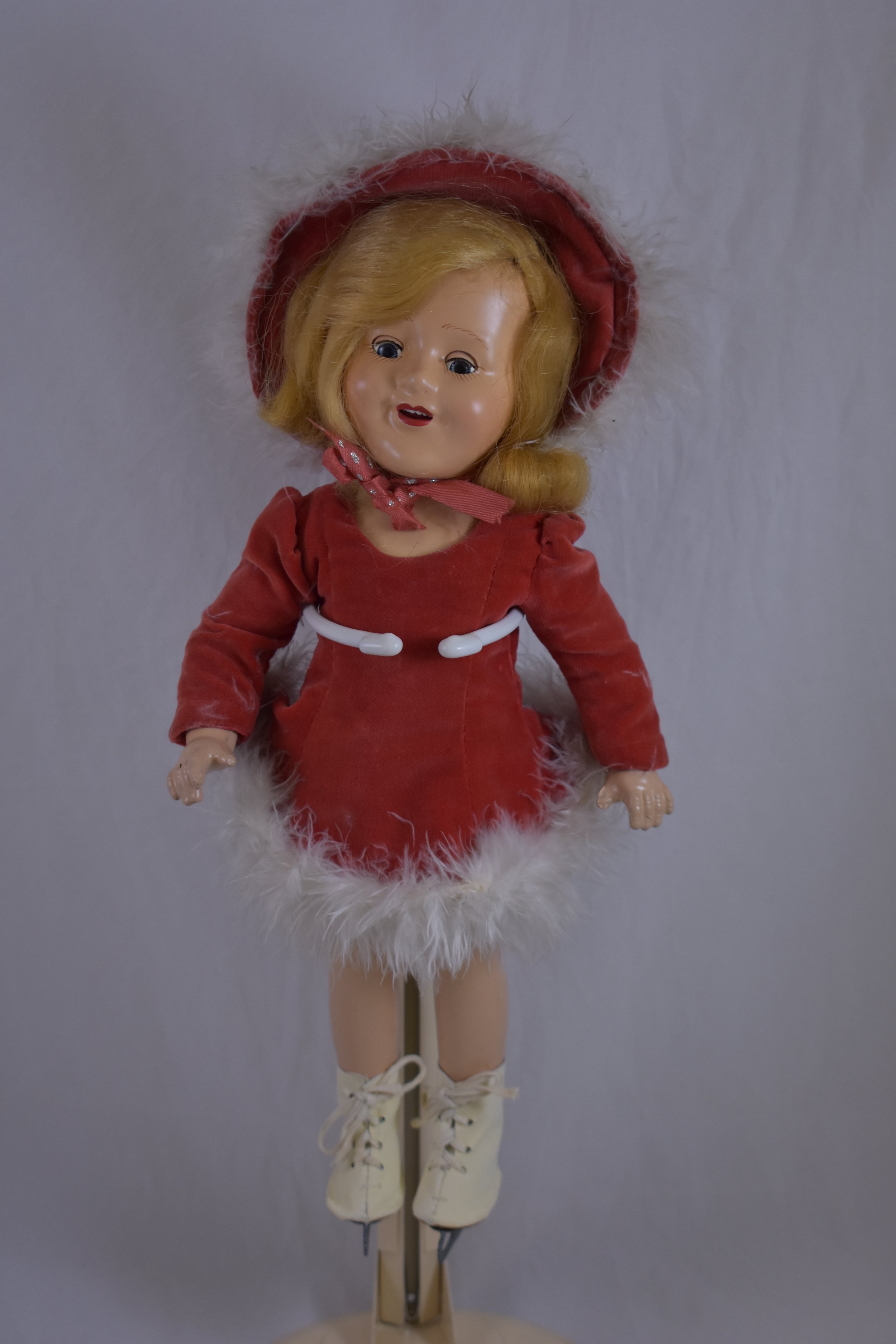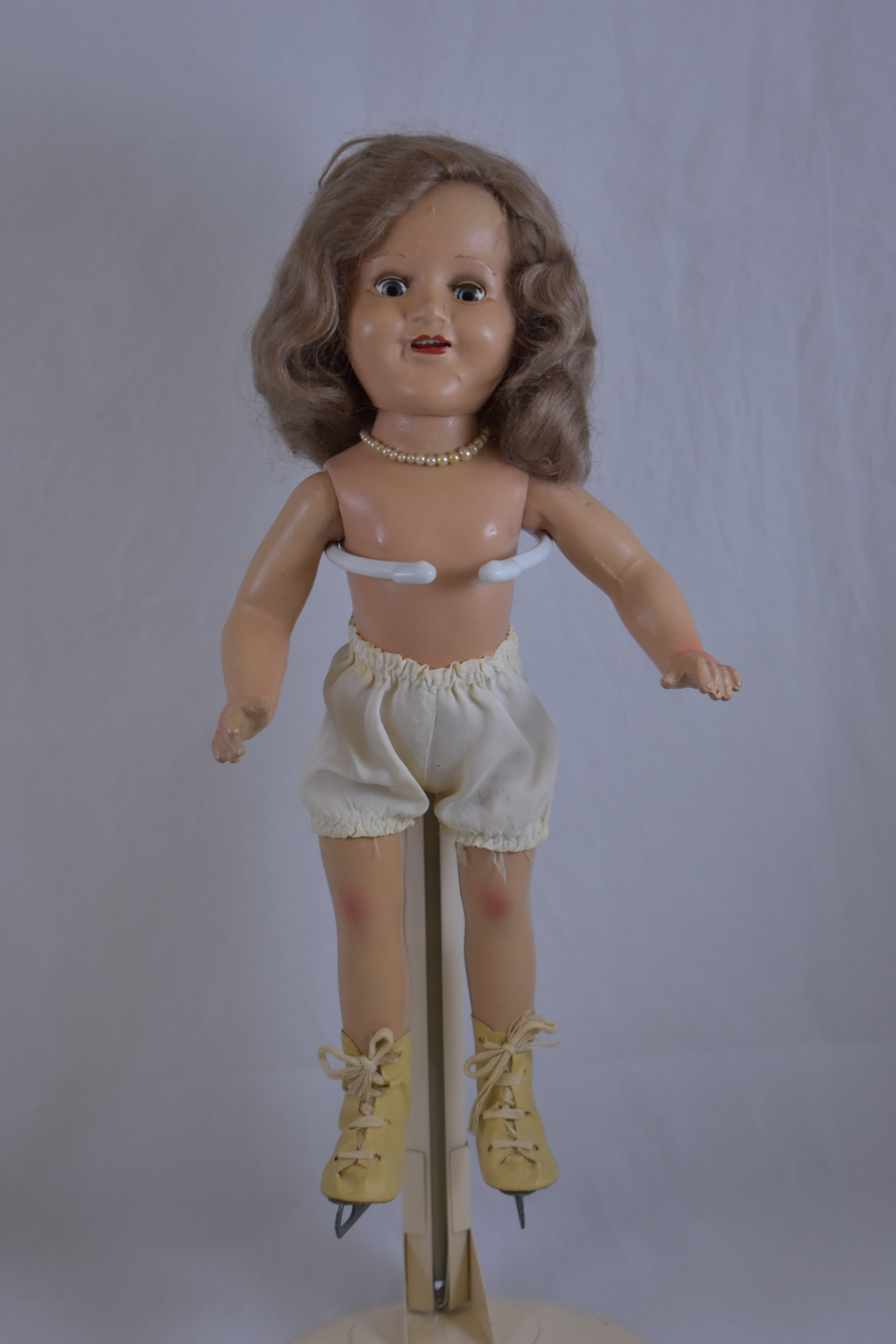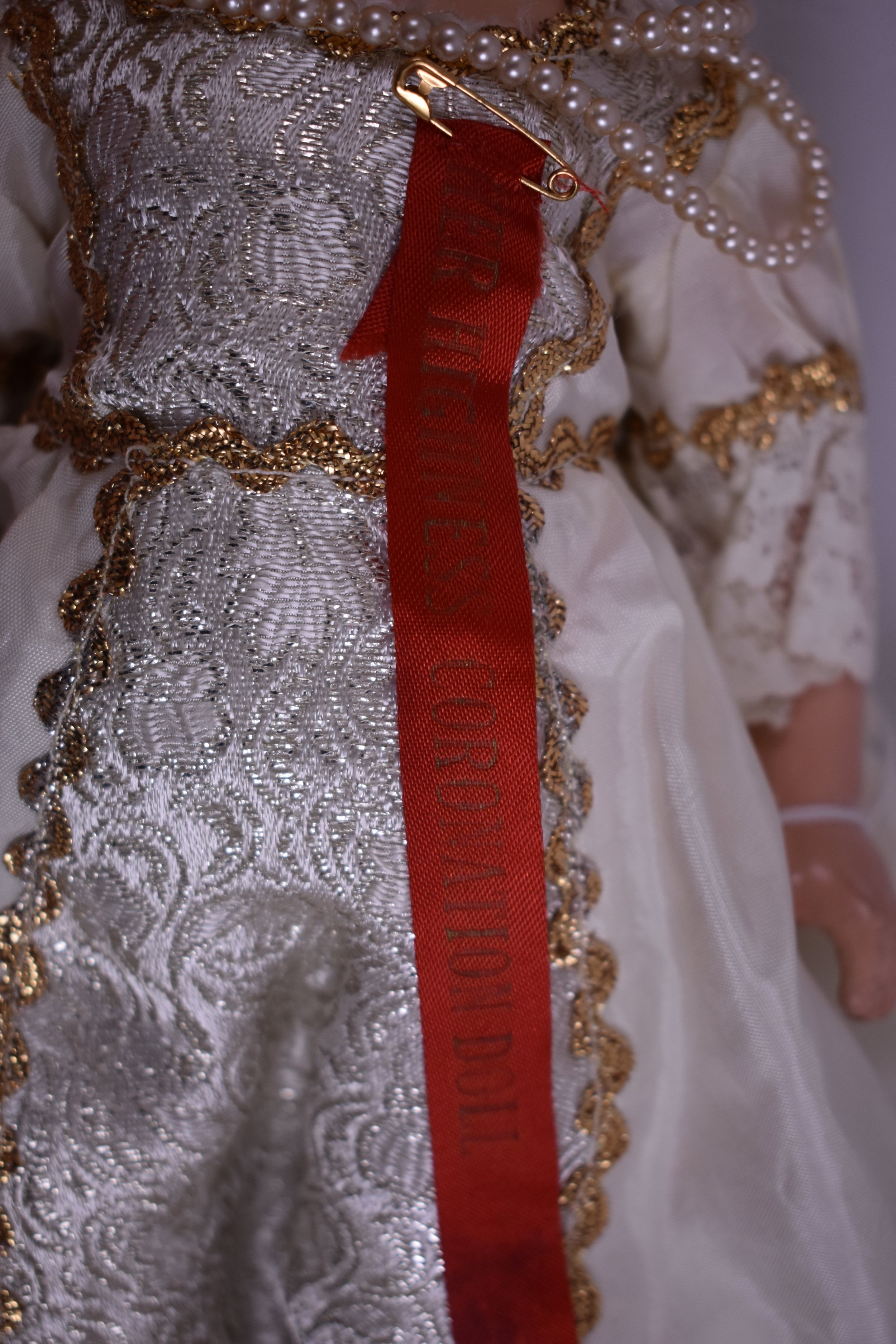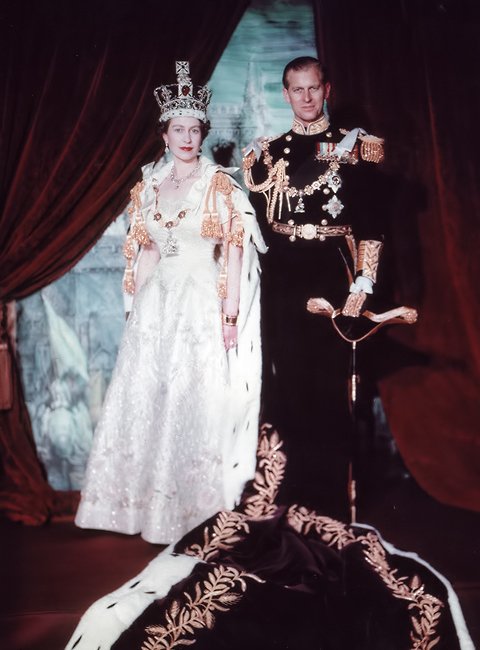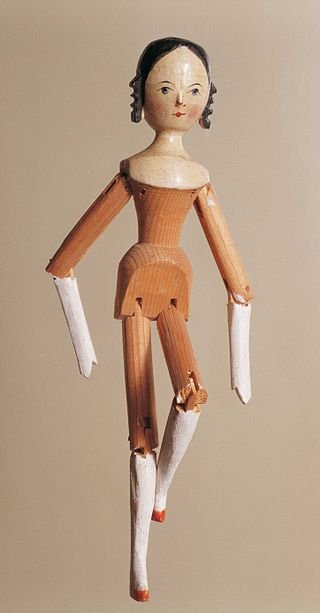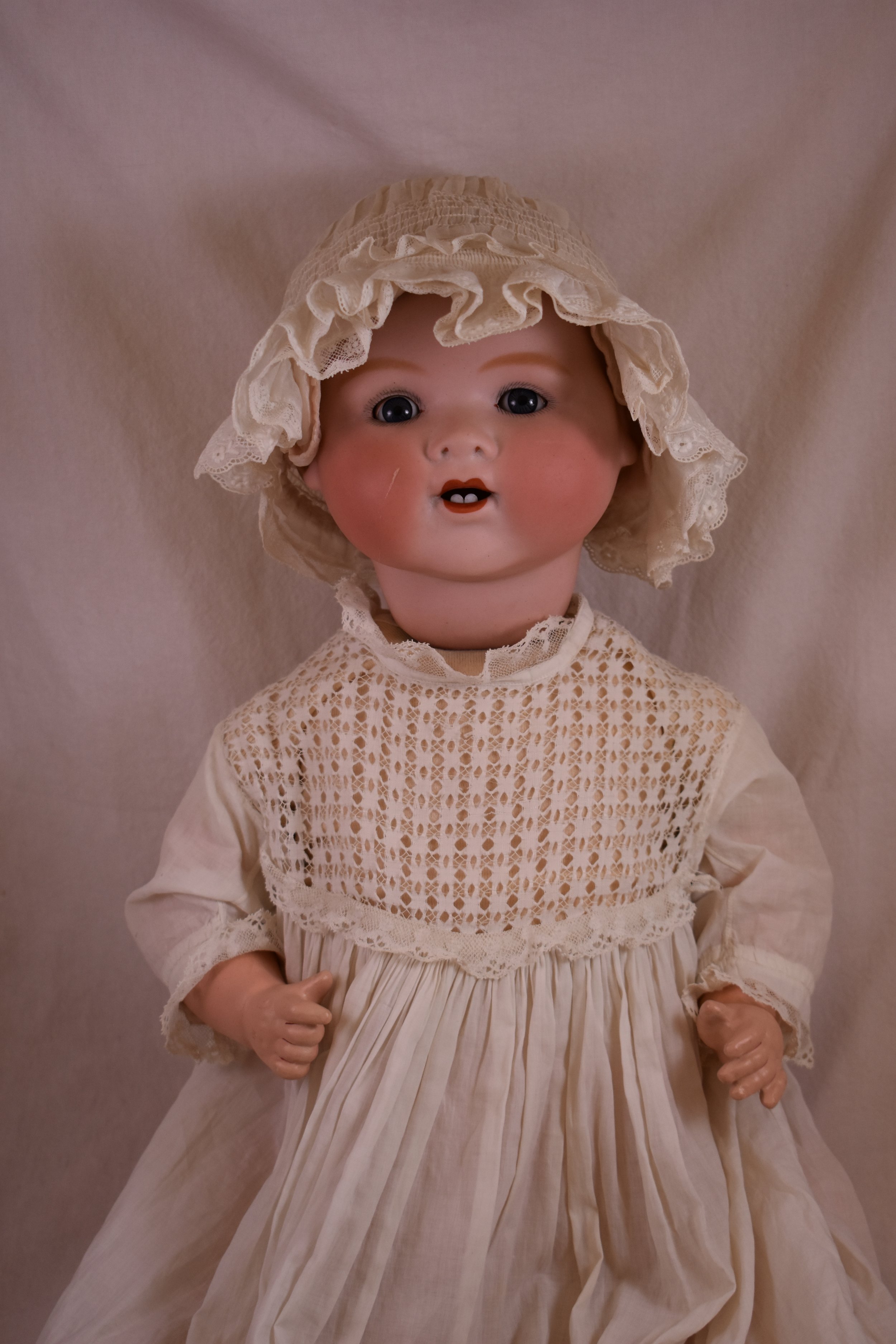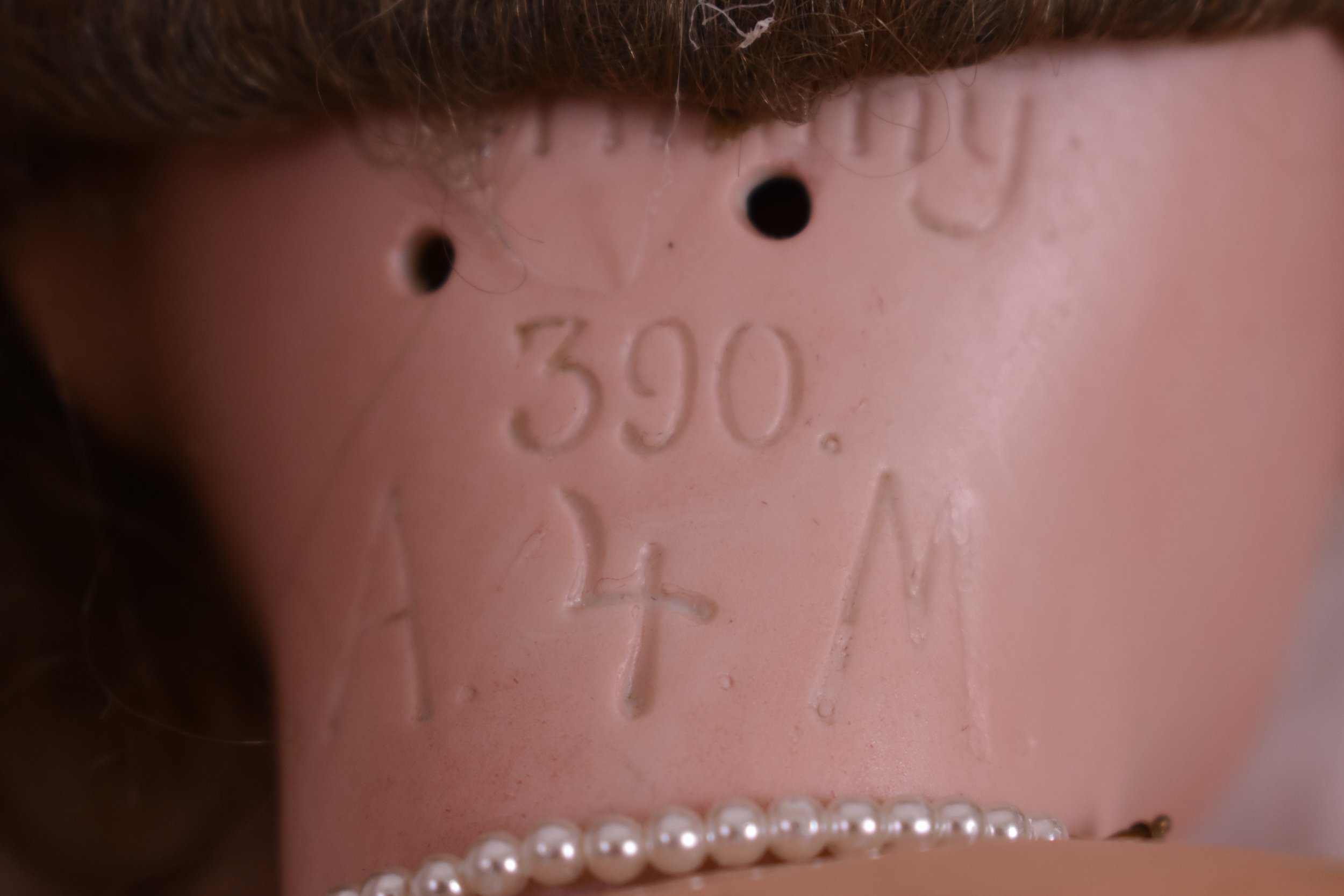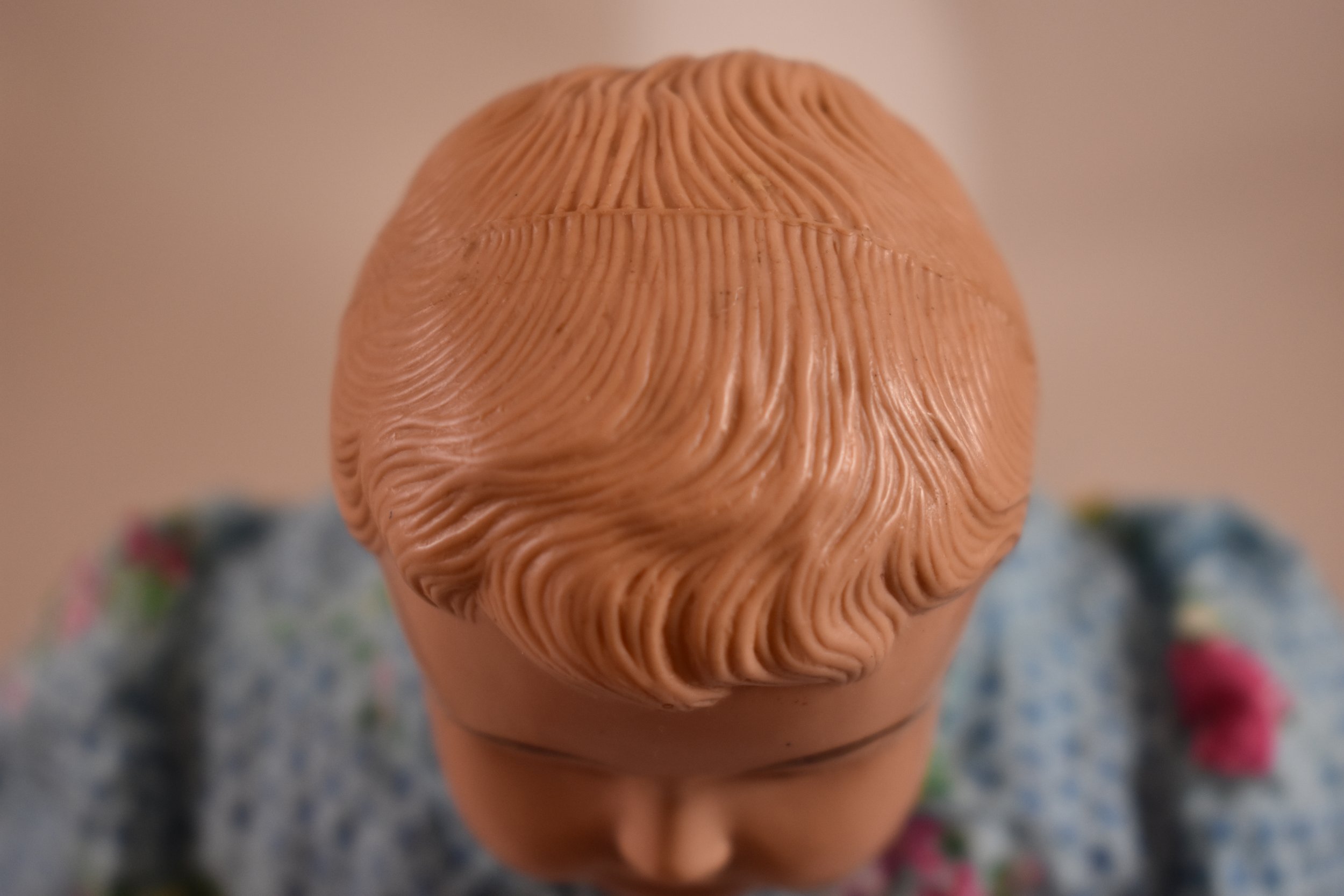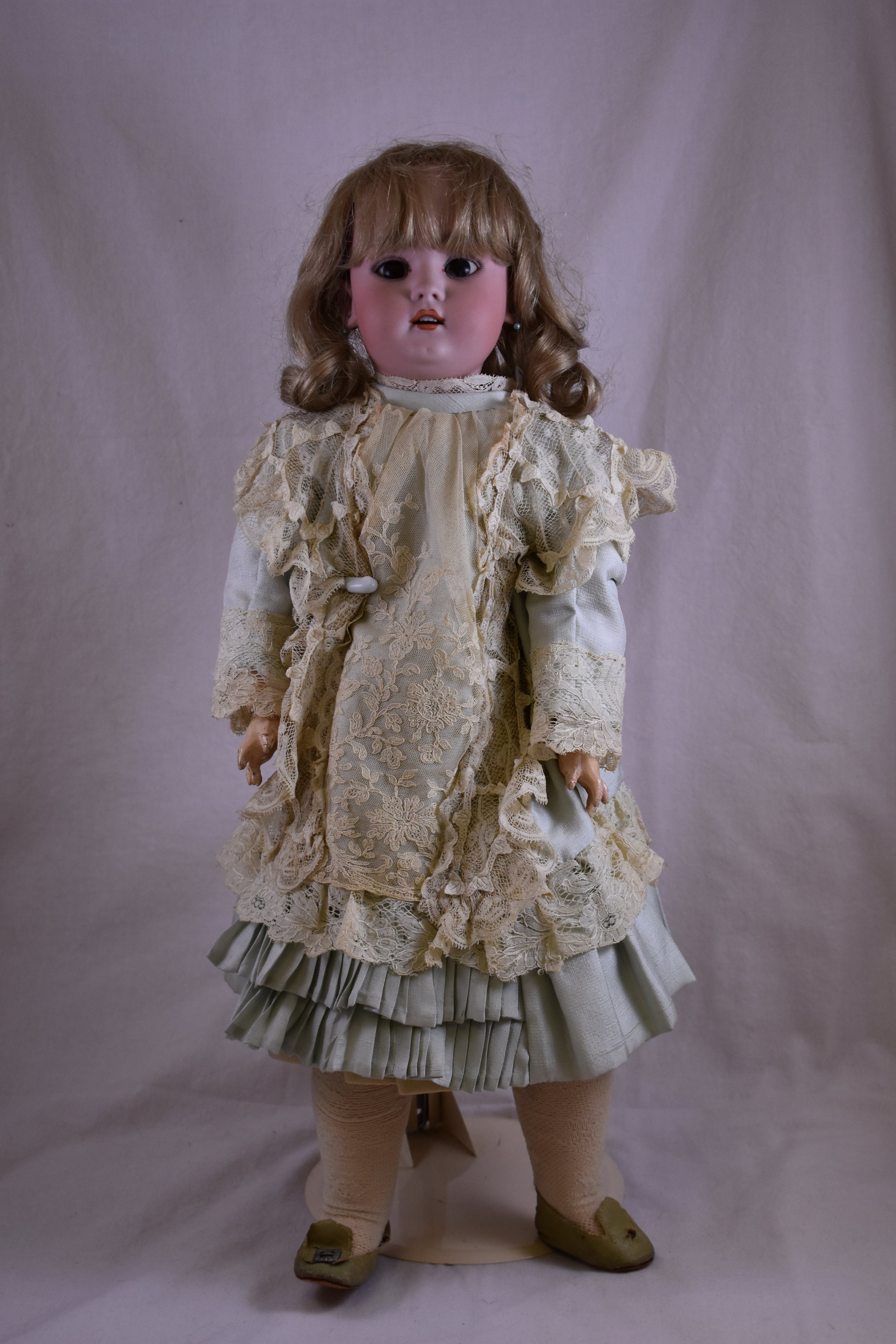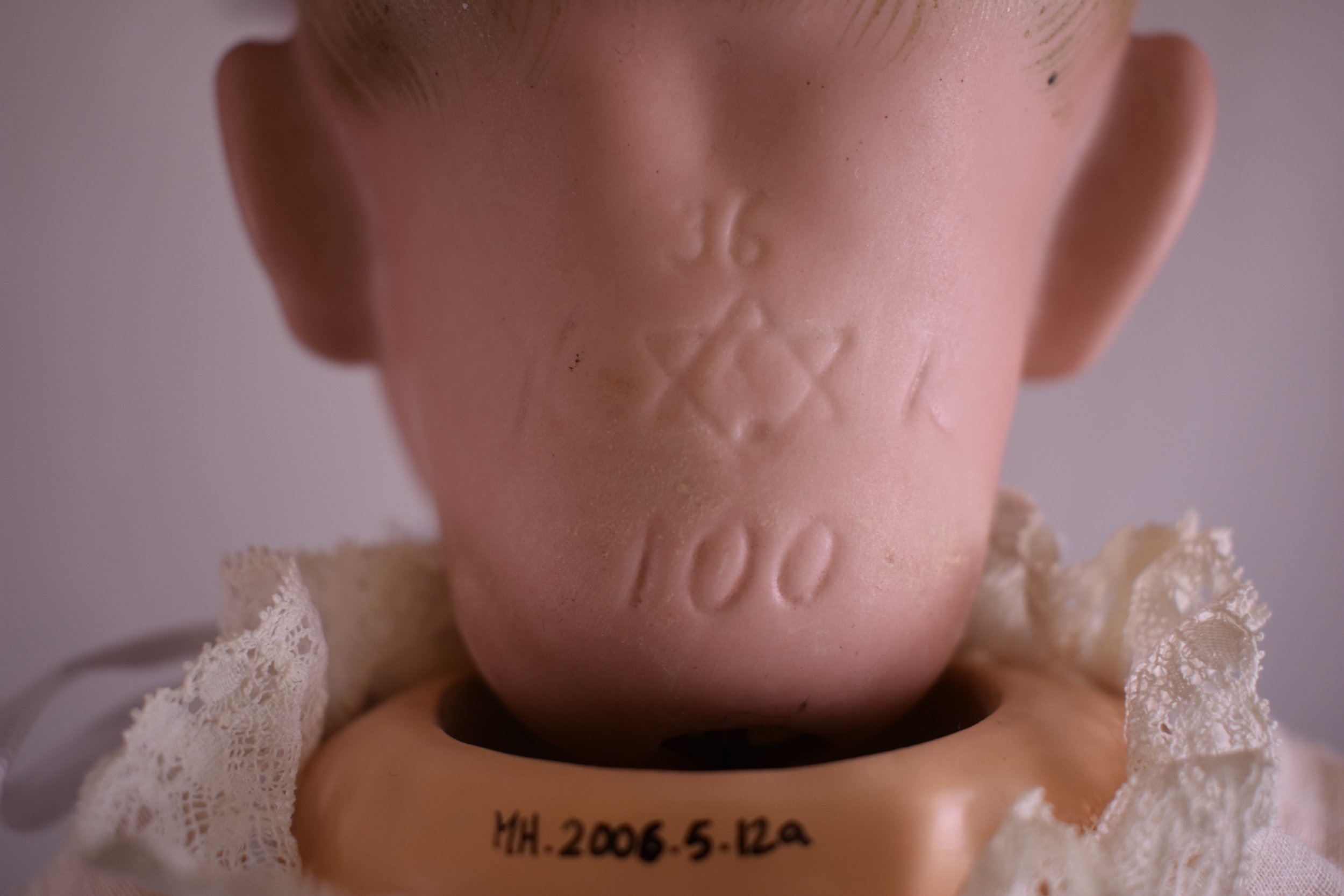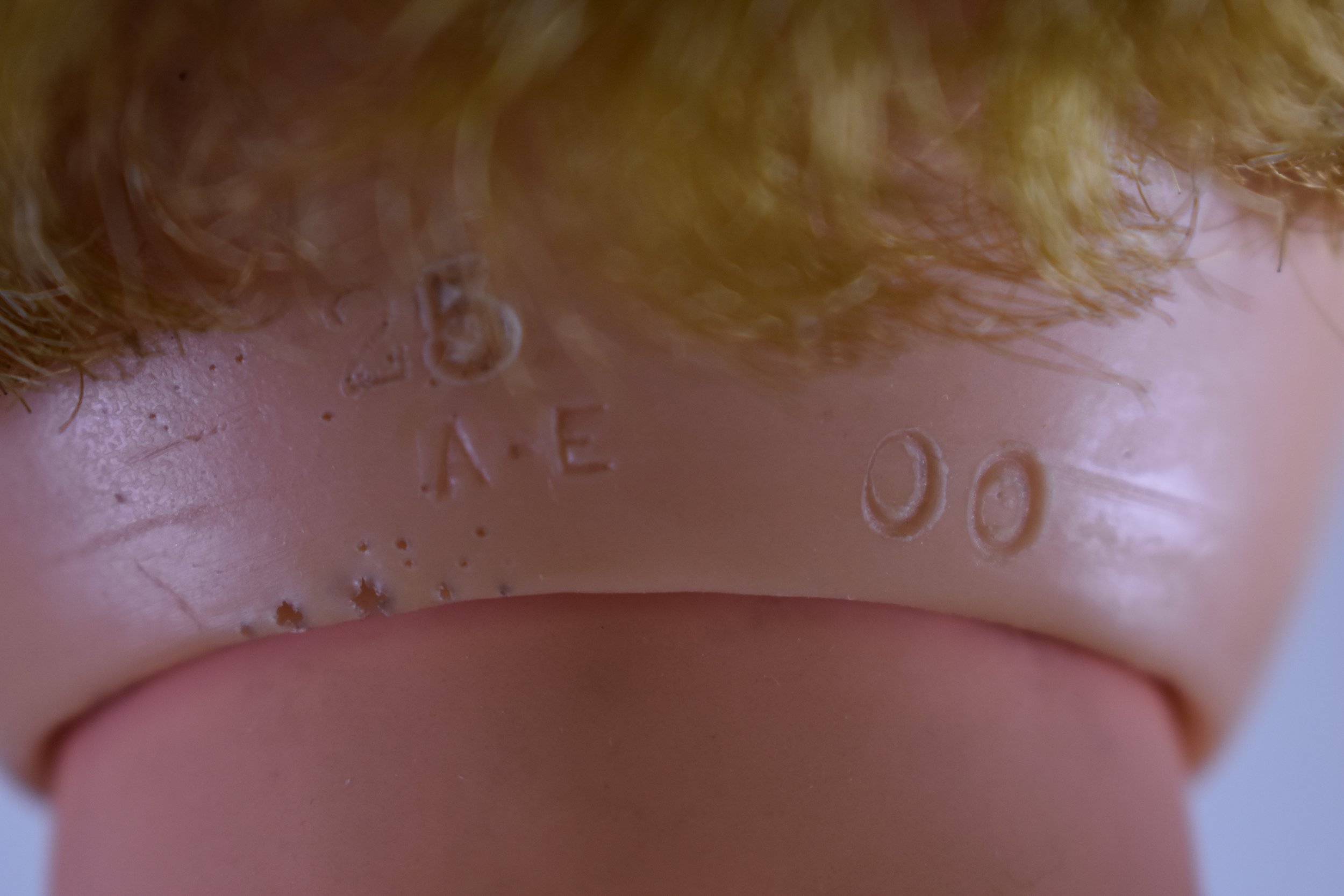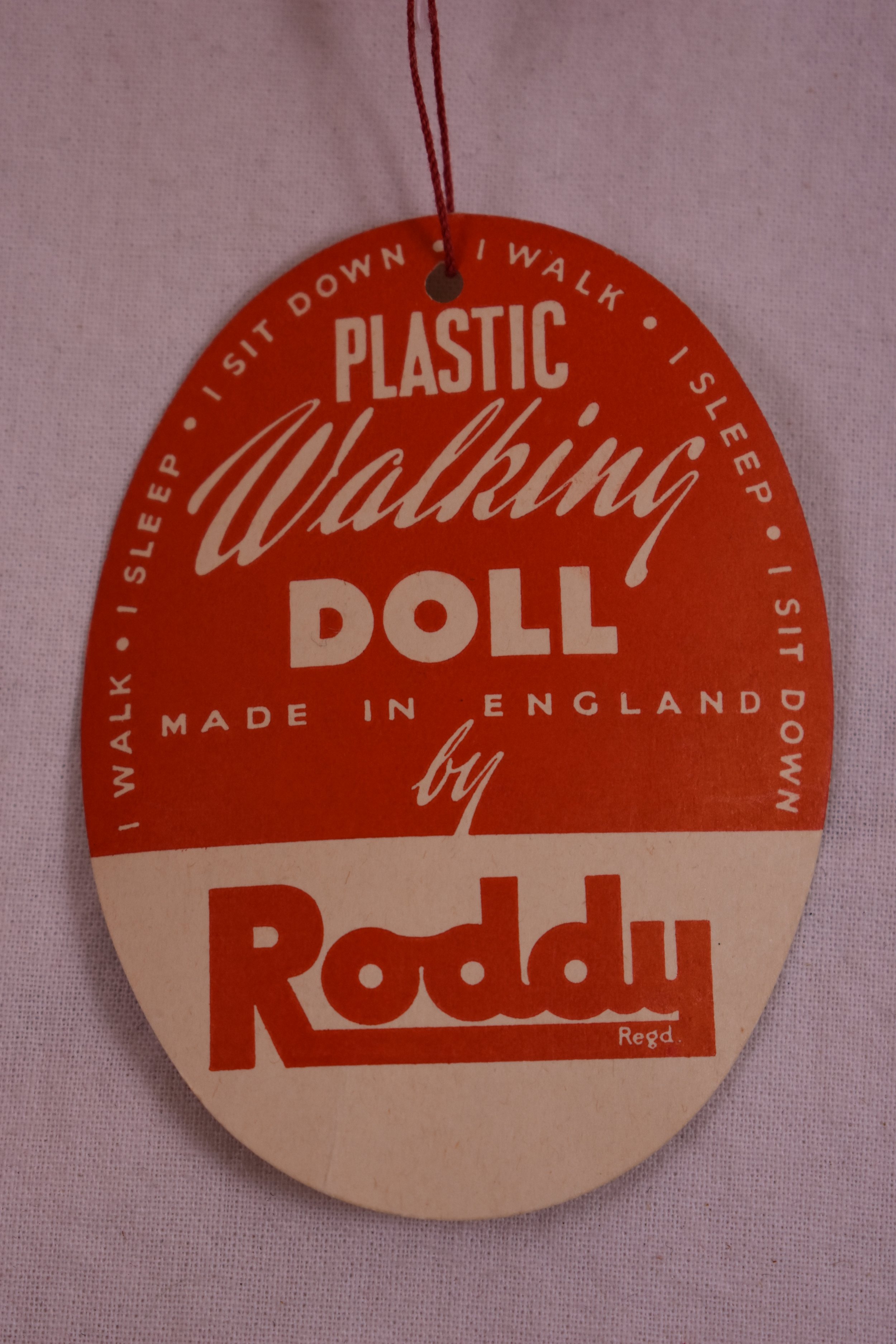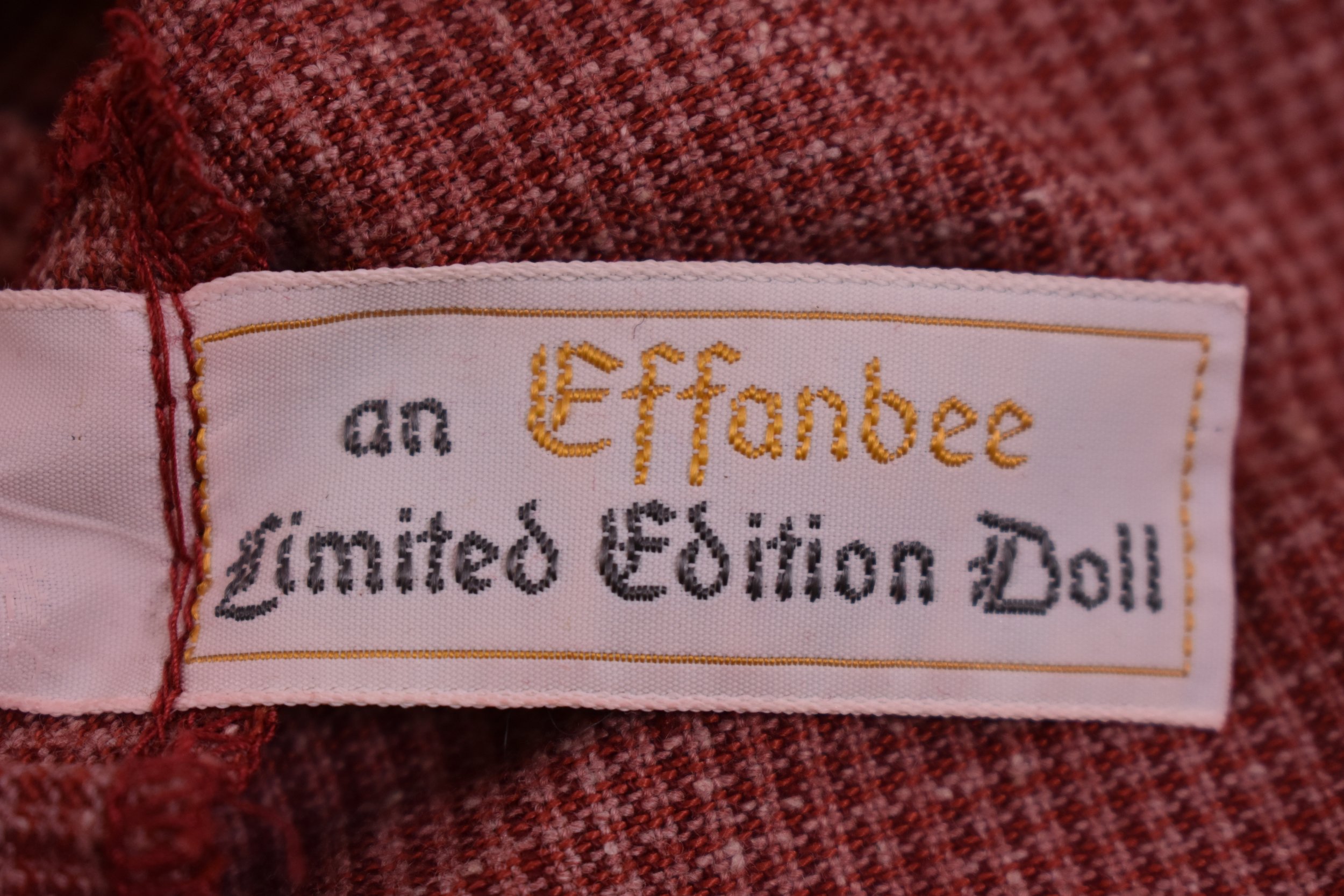The Uncanny Valley
Doll Designers
The Creators
People have always been able to create dolls from materials they have on hand. Natural materials like corn husks, apples, clothes pegs, and leftover fabric are some examples, but things like clay, wax, bone, ivory, and papier mâché have also been used to produce dolls. In the 19th Century, the Industrial Revolution paved the way for doll makers to make international names for themselves through mass production.
Click the images for more information.
Doll makers in Japan, circa 1914. Photo taken by Elstner Hinton,. Source: Wikimedia Commons
Mt. Holyoke, Massachusetts - Paragon Rubber Co. and American Character Doll. Pressing rubber doll bodies at the Paragon Rubber Factory Co. and American Character doll, Massachusetts, between 1936 and 1937 Source: Wikimedia Commons
Making dolls in Germany, 1915 Source: Wikimedia Commons
The Catenna family sews legs for Campbell's Kids dolls, 1912. Source: Wikimedia Commons
Women assembling dolls on a long worktable at the Shrenhat Toy Company, Philadelphia, 1912. Source: Wikimedia Commons
Vasily Zvyoxdochkin is credited with creating the first matroyskha doll in 1890. He was a master wood turner and wood carver, pictured here, circa 1917 Source: Wikimedia Commons
Canadian Doll Makers
Reliable Toy Company
The Reliable Toy Company was, by far, the most successful Canadian doll manufacturing company. Founded in 1920, by Solomon Frank Samuels, (who was later joined by his brothers Alex and Ben,) the company was in operation until 1995.
To begin with, the company imported bisque doll heads from Germany and attached them to bodies made in the USA, but after two years of this they began making their own dolls. Their first dolls were composition, made in a factory in Toronto that, at its peak, included doll clothing, hair-styling, shoe, eye, voice box, and squeaker departments.
World War II presented an opportunity for the company to become involved in plastic production, and this expertise meant that they were among the first companies to sell plastic toys, some of which were made from military surplus.
The dolls this company is most well known for are Canadian Indian and Mountie dolls, and the Carrie doll. They also produced their own version of Shirley Temple dolls.
Mr. Solomon also founded the Regal Toy Company, which made plastic and vinyl dolls in Toronto from 1959 till 1979. They were known for their Karen Magnussen doll in the early 1970s, perhaps because of the success of the earlier Reliable Barbara Ann Scott doll.
BARBARA ANN SCOTT FIGURE SKATING, 1946.
SOURCE: WIKIMEDIA COMMONS
Barbara Ann Scott:
Barbara Ann Scott was a Canadian figure skater who won the Gold Medal for ladies’ singles figure skating in 1948, the only Canadian woman to do so, to date. She was also a Canadian, European, and World Champion skater. She was known as ‘Canada’s Sweetheart.” Reliable immortalized her with a doll.
The Barbara Ann Scott dolls were composition, and each year came with a new outfit, always trimmed with marabou. The first outfit was a lace skating costume. The doll was made until 1954, came with a tag shaped like an ice skate, a letter from Barbara Ann, a pair of shoes and a pair of skates. A little book could also be purchased.
This version of Barbara Ann Scott is from 1950, in red trimmed with marabou.
Barbara Ann Scott's doll skates
The composition body of another Barbara Ann Scott doll and another pair of skates.
Barbara Ann Scott's doll skates
Below, Hair Bow Peggy, from 1935, has a composition head and arms, and a cloth body stuffed with “excelsior”, also known as “wood wool”, made from wood slivers. Her molded hair was softened by the fact that she had a molded loop where a decorative bow was placed.
Reliable created the following doll to commemorate the coronation of Queen Elizabeth II, in 1953. Her ermine lined cape is a little more lavish in real life.
Queen Elizabeth II's Coronation, 1953. Source: Wikimedia Commons
Earle Pullan Limited
Earle Pullan Limited was a Canadian doll company that made, primarily, hard plastic, soft rubber, and vinyl dolls between 1945 and 1967, though did make some composition dolls in the early days of operation. Two dolls they were well known for was “Miss Lucky Green",” a promotional doll make for Loblaws, obtained by saving Loblaw’s lucky green stamps. Miss Lucky Green came in a variety of sizes and styles.
Pullan also produced a promotional doll for Heather Hill Appliances, later known as Bad Boy Appliances, because of the doll. The Little Mister Bad Boy doll was given out for free with new major appliance purchases in the 1960s. Dee and Cee also manufactured a Bad Boy doll.
Dominion Toy Manufacturing Company
The Dominion Toy Manufacturing Company operated from 1911-1932 and originally created dolls with very lifelike heads and fairly un-lifelike bodies, often with large metal disks in the joints. They sold dolls in a wide range of prices, and had walking and talking dolls as well. The company was founded by Aaron Cone, who was also a partner in the Ideal Toy Company. Dominion designed many of Ideal’s character dolls. In 1933, the Reliable Toy Company bought out Dominion’s assets, further securing their dominance in the Canadian doll making business.
Dee and Cee
Dee and Cee was founded by Max Diamond and Morris Cone. The company operated in Toronto from 1938 until 1962. Many of their dolls were made under license agreements with American companies which included Horsman and American Character. They made Canadian Versions of many American dolls. The maker’s mark on Dee and Cee dolls varies and includes versions such as Dee an Cee, D&C, Dee Cee, DC, and Deeancee.
In 1962 the company was acquired by Mattel.
German Doll Makers
Many countries have long histories of doll-making, but Germany was one of the longest standing mass producers of dolls in the world. Beginning in the early 1700s, making use of the dense German forests, doll makers began making dolls turned on wood lathes. These were followed by papier mache dolls, which could be mold-made, in the 1800s. In the area of Thuringia alone, at the peak of the industry’s production, there were over 500 different doll makers. Later developments included making use of the porcelain clay found in the area. Porcelain factories adapted to become doll making factories. The area attracted artisans and artists and the results were some of the best made dolls of the last few centuries. The industry was never the same after World Wars I and II, though did produce at least one memorable doll after that era: the Bild Lili dolls were first made in 1955, and were the inspiration for Ruth Hansen’s Barbie doll.
Some other notable dolls produced in Germany included; Dutch peg woodens made on hand-powered lathes, Whistling Jim, a bisque doll that had a small bellows inside and could whistle, porcelain Piano dolls, which were usually porcelain and designed for display on pianos, instead of as play things, Tauflinge dolls which were originally made of turned wood and wrapped in swaddling clothes. Tauflinge means “before christening.” Later Tauflinge dolls were made of papier mache, dipped in wax.
Armand Marseilles
Dolls marked with A.M. were made by Armand Marseilles, considered to be one of the largest and most well-known doll makers from Germany. Though the dolls produced are called Armand Marseilles dolls, in fact, the company only made doll heads which they either exported to other doll makers, or put on doll bodies they purchased from other companies. Armand Marseilles was born in Russia in 1856 but ended up in Sonneberg and Koppelsdorf, Germany, after his family moved there. In 1884 he bought the Mathias Lambert toy company, and then a year later, the Liebermann & Wegescher porcelain factory. He built up his business from there, and at the peak of production from 1900 to the 1930s, was making up to 1000 bisque doll heads per day. The company made, exclusively, bisque doll heads.
The most commonly found doll heads, today, are doll molds 370 and 390. Number 370 is a shoulder head on a cloth or kid body, and 390 is a socket head on a composition body. The company also produced the heads for some of the Eaton’s Company’s “Eaton’s Beauty Dolls.”
Gebrüder Heubach
Gebrüder Heubach’s family were porcelain producers in Thüringia, Germany, starting in 1840. In the early 1900s, Gebrüder Heubach added bisque doll heads to the family’s porcelain figurine business. Their doll heads were both socket and shoulder head dolls, much like Armand Marseilles’. Some had molded hair, while others had wigs. Some Heubach dolls were famous for “intaglio eyes”, eyes that are inset or cut into the head, then painted.
Heubach took advantage of the proximity of an artists’ school near the factory, hiring sculptors to create doll heads. Some of these artists’ initials can be found on Heuback dolls, including Holwein, Krieger, Niemeyer, Wera vonBartels, Zeiller, and Zitzmann. The Heubach trademarks include sunrise or square shapes, with GH inside.
This Heubach doll has a bisque head, with an articulated, composite body.
Gebruder Heubach rose shaped tag, identifying this doll as Rosemarie.
Gebruder Heubach doll trademark and mold number.
A jaunty Gebruder Heubach boy doll, in red velvet, without his hat....
..... and with his hat.
Rheinische Gummi Und Celluloid Fabrik Co
The Rheinische Gummi Und Celluloid Factory dates back to 1873 and eventually became known as Schildkrotwerke (Turtle Works, schilde meaning turtle in German). They initially used celluloid to produce items such as umbrella handles and hair combs, but later turned their attention to dolls. The turtle shaped trademark was registered in 1899, and over the years included variations on the theme. The company faced hardships during the war years, but began producing dolls again in the late 1940s, using an improved material, called tortulon, a hard plastic that was not as flammable as celluloid, which is known to be an unstable substance. The USA banned dolls made of celluloid in the 1940s.
The company also produced dolls for other companies, including Kestner, Kammer & Reinhardt, and others.
This celluloid boy doll is named Ben. The turtle mark on his back and the fact that his arms can move, indicate he was made in the early 1930s. The girl, Amy, has a celluloid head mounted onto a cloth body that probably dates this doll to pre-1908 when they began making the entire doll from celluloid. Her hair exemplifies the deeply molded hair these dolls were known for. Note the two variations of the maker’s mark on these dolls.
Ben
"Schutzmark" above the turtle.
Amy
"Schutzmark" below the turtle.
A fine face
Deeply molded hair
Schoenau & Hoffmeister
Arthur Schoenau bought a doll factory in Germany in 1884 and began making dolls. In 1901 he went into partnership with Carl Hoffmeister. The company made bisque doll heads for cloth-bodied dolls or “nanking dolls.” They also produced dolls made with papier-mâché. A dispute over whether to make shoulder heads versus socket heads for their dolls led to a parting of the ways for these two in 1907, and the Schoenau family continued making dolls until 1953. The company produced a Princess Elizabeth doll in 1929, modeled after three year old Queen Elizabeth. However, Buckingham Palace deemed the doll “too chubby” and the design never went into full production. There are only a few in existence. Shoenau and Hoffmeister also made the Eaton’s Beauty dolls, but only for the 1908 –1909 catalogues.
A beautiful Schoenau and Hoffmeister doll with bisque head, and a jointed composition body.
The Schoenau and Hoffmeister maker’s mark.
This image shows both the composition body material, as well as the ball and socket joint and its ligature.
J. D. Kestner
Johann Daniel Kestner began making dolls in the 1800s, beginning with papier mâché and wooden dolls, followed by wax over papier mâché doll heads, and bisque heads. The wax doll heads are prized by collectors. Kestner was also one of the first suppliers of Rose O’Neill’s famous Kewpie dolls. The company also made dolls with kid leather bodies. Over the years, Kestner dolls were distributed by many companies, including Sears, Macy’s, Horsman, and FAO Schwartz. At its peak the J.D. Kestner Company employed nearly three quarters of the population of the Waltershausen region in Thuringia, Germany. His local nickname was King Kestner. The Kestner maker’s mark may include the initials JDK or the Kestner crown and streamer label. A rare find is a Kestner doll with pierced ears.
Simon and Halbig
Simon & Halbig made bisque doll heads from their two porcelain factories in Germany, primarily for other doll makers. After Simon died in the early 1900s, his wife sold the workshop to Kammer & Reinhardt, who continued making dolls, but with more durable composition bodies, until 1932. As a result of this sale, many dolls may have both the Kammer & Reinhardt, as well as the Simon & Halbig, makers’ marks.
A well dressed Simon & Halbig doll, complete with earrings
The Simon & Halbig maker’s mark
This Simon & Halbig doll has a bisque head, a pink, kid leather body and composition lower arms and legs.
This Simon & Halbig doll has a bisque head, a pink, kid leather body and composition lower arms and legs.
This doll is a Jutta doll, a series of dolls first produced in 1907, named in honour of the Countess Jutta of Sonneberg.
A Kammer & Reinhardt baby doll in christening gown
A very realistic facial expression
Simon & Halbig trademark
More Creators
Browse through this collection of dolls made by other notable doll makers from around the world.
Topper Deluxe Reading
Topper Deluxe Reading was an American company that sold their dolls under various company names that included Deluxe, Deluxe Reading, Deluxe Premium Corp, Deluxe Topper, Deluxe Toy Creations, Topper Toys and Topper Corp. The company made dolls between 1955 and 1973 and sold them, mainly, in grocery stores earning them the nickname “Grocery Store Dolls.” Three of their well-known dolls were the Dawn doll, Betty Beautiful Bride, and the Penny Brite doll. They were also the first company to produce Sesame Street dolls. They made their dolls with plastic and vinyl and this made them a more affordable alternative for people.
Penny Brite was a popular Topper Deluxe Doll, created between 1963 and 1970.
She came packaged with a booklet showing additional Penny Brite accessories. There were numerous additional outfits that could be purchased for Penny, as well as gift sets with pieces for a parlour, school room, travel, etc.
Penny Brite doll
Betty Beautiful Bride doll
Betty Beautiful Bride doll
Betty Beautiful Bride doll hand
Betty Beautiful Bride doll trademark
Mattel
Perhaps one of the most recognizable doll maker company names is Mattel. Founded by Harold Matson and Elliot Handler in 1945, California, the company grew to become a multinational company. Matson sold his share to Elliot’s wife, Ruth Handler, who became famous for being the creator of Barbie, which she based on a German doll, named Lili. In 1974, the Handler’s lost their company after being charged with issuing false financial reports, and the company changed hands. Mattel, though, is still in business with a long list of popular dolls to its credit. Some of the company’s earliest successes were Chatty Cathy and Barbie, but a walk through any toy department will show that there are many current successes.
“Tiny Swingy” made by Mattel in 1968, was a battery operated doll that moved her head, body and swung her arms. Tiny was 11.5 inches tall, and regular Swingy was 20 inches tall.
A Mattel Trademark
A Mattel Trademark
Little girls in 1979 could look forward to perfecting a beauty routine with Barbie’s help.
Barbie, 1979
Ricky was created to be a friend to Skipper and is indelibly stamped on the buttocks with “Skipper”.
Skipper Trademark
B. Shackman & Company
Bertha Shackman took over the business, started by her husband in the late 1890s, when he died in 1898. She ran B. Shackman & Company successfully long before it was common for women to be in business. The company made and sold inexpensive toys and novelties in New York City. One of their catalogues, from the early 1900s, runs to 206 pages. Shackman often made things very similar to more popular brands and one of their dolls, the Sleep Baby, became well known. It came in blue, pink and red.
Shackman Doll
Shackman Trademark
Mark Farmer Doll Company
The Mark Farmer Doll Company was one of many companies that began reproducing china doll parts in the the late 1940s. Some of these companies, including Mark Farmer, used antique doll molds to create their doll heads. Started by Emma Clear and Mark Farmer, in California, the company was primarily run by Emma Clear after she and Mark parted ways. Their catalogue was known for its inclusion of tidbits about Emma’s children, who were also used as models for dolls. In an era of Civil Rights unrest, the Mark Farmer Doll Company had a racially integrated staff. The company was in business until the 1970s.
A Mark Farmer Doll.
Undressed, the various china parts, sold by the Mark Farmer Doll Company, can be seen.
D. G. Todd Co. (Roddy Doll Company)
Based in Lancashire, England, the Roddy Doll Company, as it was sometimes known, operated from 1938 until the 1950s. They started out making composition dolls, named after the owners Daniel Todd and Jack Robinson. During World War II they were unable to produce dolls, but started up again in 1945. Shortly after this, they made their first hard plastic dolls, then began making vinyl dolls around 1950.
A “Roddy Doll,” made in England. This plastic doll is a post-war doll.
"Roddy Doll" tag
"Roddy Doll" trademark
Ideal Toy Company
The Ideal Novelty and Toy Company created the Teddy Bear, named after Teddy Roosevelt, in 1903, and with that success began making composition, “unbreakable” dolls in 1907. The company was founded by Morris and Rose Michtom and when Morris died in 1938, the company became The Ideal Toy Company. It was the largest doll making company in the United States in the Baby Boom Era. Their first doll was “Yellow Kid,” named after a comic strip by Richard Felton Outcault. One of their earliest successes was Betsy Wetsy. They also made a boy doll called, “Uneeda Kid,” named after a biscuit factory, and made many character dolls, notably Shirley Temple and Judy Garland, and “Admiral Dot,” modeled after a dwarf performer with P.T. Barnum’s circus.
Admiral Dot cabinet card, 1873.
The Yellow Kid, a popular comic strip about a good natured, slum dwelling kid, circa 1890s.
Pintel and Godchaux
Pintel and Godchaux was a French doll company founded in 1887. They operated until 1899, at which point they joined Société Française de Fabrication de Bébé & Jouets and under this umbrella continued making dolls with their trademark. Two things Pintel and Godchaux were know for was a patent for a doll with a diagonal hip joint, and for a doll trade name, “Bébé Charmant.” Their dolls had bisque heads and jointed composition bodies.
A Pintel and Godchaux “Bebe Charmant”
A sweet face
Bebe Charmant stamp on her petticoat.
Morimura Brothers
Morimura Brothers was in operation from 1876 to 1941. Based in New York City, they imported Japanese dolls with bisque heads copied from German styles. These were either “character babies” or “dolly faced dolls.” Dolly faced dolls refers to dolls with “a pleasing and expressionless countenance.” In addition to these they also made all bisque dolls, celluloid, nanking, composition and rubber dolls.
This doll shows how similar the Japanese Morimura dolls were to German ones.
Louis Marx Co
The Louis Marx Company was founded in 1919 in New York City, and originally made tin wind-up toys and later specialized in low cost, mass produced toys, such as a whistling and a non-whistling yo-yo, of which 100 million were sold within a decade. In the 1960s, through the ‘70s the Louis Marx Company made hard plastic and vinyl dolls; in particular, action figures. The best known of these were the Johnny West doll family.
This Louis Marx Company doll, affectionately known by museum staff as “small man, brown pants,” has the very low-cost body construction typical of their dolls. The Johnny West family dolls were very similar in appearance but were injection molded of a hard plastic, with softer head and hands, then put together into a highly pose-able action figure. These dolls were contemporaries of G.I. Joes.
A small man, in brown pants.
A serious face.
Bendable arms.
Lenci
Elena Lenci and her husband Enrico Scavini produced pressed felt dolls in Turin, Italy, from 1919 until 1944 when the factory was destroyed in an air raid. The dolls’ faces were pressed in molds, the faces were painted and the hair was mohair, stitched onto the scalps. The dolls all looked sideways. The bodies were primarily machine stitched, with the exception of the area between the legs, which was hand-stitched. The trademark, Lenci, is stamped onto the underside of the dolls’ feet. The famous “Lonely Doll” series of books, written by Canadian – American, Dare Wright, featured the author’s childhood Lenci doll, named Edith.
Cover of one of the Lonely Doll Books, 1957.
A well-dressed Lenci doll.
The Lenci Dolls looked to the side and had skillfully painted faces.
The Eros doll company, of Florence Italy, was a direct competitor to Lenci, and operated during the 1920s, offering similar dolls at a more affordable price.
The two lovely felt Eros dolls below are named Lulu and Luca. Like the Lenci dolls, these look to the side. They each came with their own box, with a gold label.
Eros felt doll, Lulu
Eros felt doll, Luca
Gold label
Eros doll box
Effanbee Company
Effanbee stands for the F & B initials of the company’s founders, Fleischaker & Baum. The company began in 1910, in New York City. They made dolls from hard rubber, composition, cloth, and vinyl. Effanbee was known as one of the first companies to make a realistically proportioned doll, named Patsy. Patsy had a large wardrobe and a fan club. They also produced one of the first drink and wet dolls, DyDee Baby, and had talking dolls, character dolls, and boy dolls.
These two Effanbee dolls are more recently made. As can be seen stamped on their necks, both are Limited Editions.
Skippy
Proof of identity
Limited Edition stamp, 1979.
Effanbee's Limited Edition tag.
An Effanbee Doll designed by Dewees Cochrane.
This Effanbee doll is stamped with "Dewees Cochrane." Dewees Cochrane was a well-known doll artist who designed artistic dolls that were made to be played with. One series of dolls she made in the 1930s, was based on six basic face types, that she formulated after studying hundreds of photographs.









